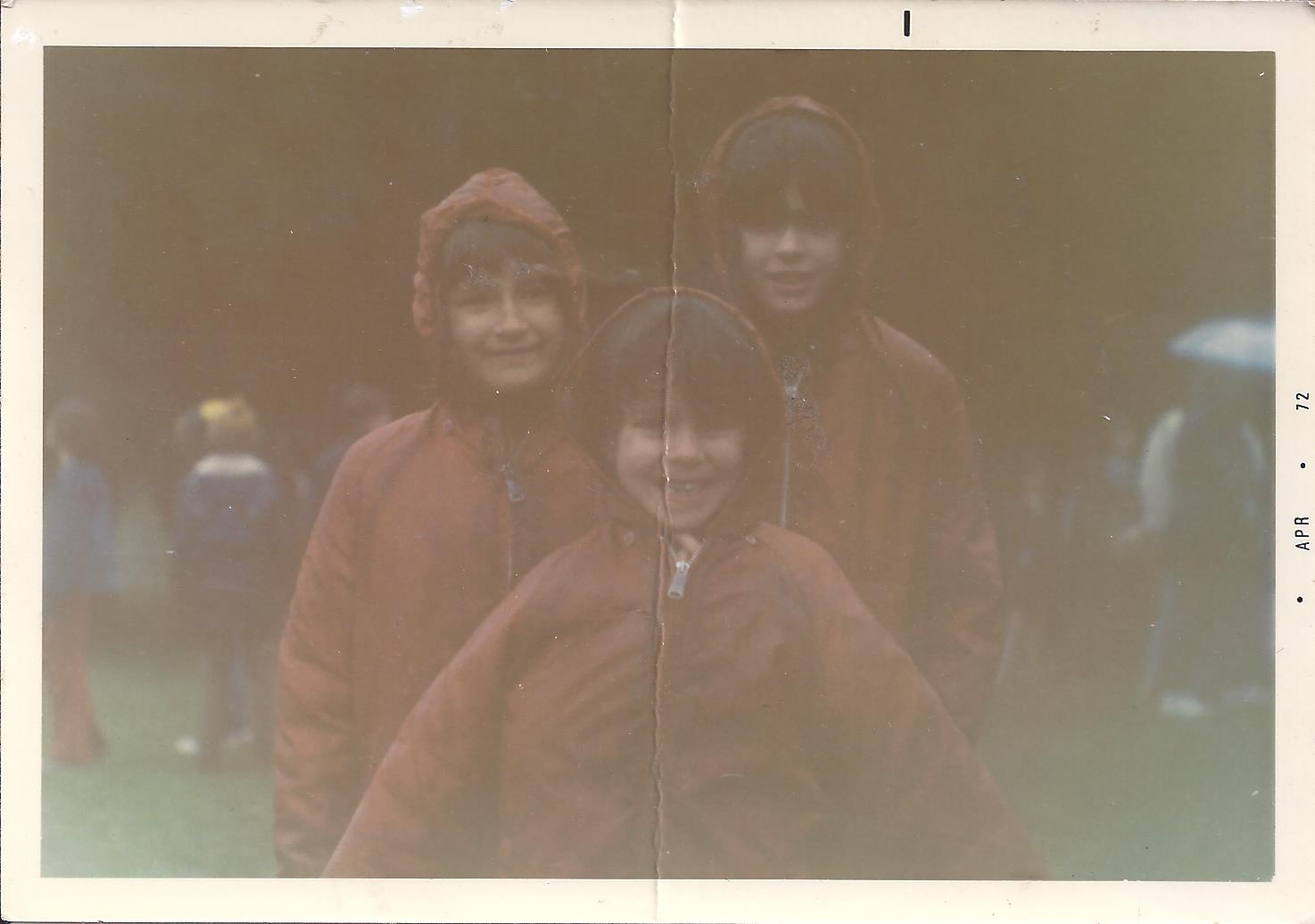In the 1970s, my father owned an Army surplus oilskin tent. In my three-foot-tall memory, it slept ten people. I didn’t even know hotels were an option until I was in high school. Growing up in Washington State, I spent many rainy nights—and more than a few rainy days—in that tent with my sisters and my dad. Though I did not realized it at the time, I learned a lot about leadership while camping with my dad.

Given the right reason, we will slog through mud.
The truth is that I did not love camping or hiking when I was little, but I loved being with my dad. If he wanted to hike the Ozette trail to show me an archeological site, I was all in. Of course, at seven, I did not understand the gravity of what I was slogging through the mud to see. Still, he took the time to explain why it was so important in terms I could understand and that made me feel important to him, too. He also clearly believed that I could do it. He must have because my dad was a smart man, so he would never have left on a hike if he thought he would be carrying a hiker back. Leadership is a two-way relationship. My team members not only need to understand what we are trying to accomplish, they need to know that I believe they can accomplish what we set out to do. This cannot be a secret I am withholding in hopes that it will motivate them to work harder. They are the key to our success. They matter. Their skills, experience, and training are valued. Their unique perspectives and abilities—individually and collectively—cannot be replaced easily. If I want them to hike a muddy trail in the rain, I have to give them a reason to follow me. They must know that I hold these beliefs about them and about us as a team.

Map out the target and the path.
I never knew exactly where we were going. He gave me the name of our destination and a promise that the sight of it would be awe-inspiring. Yet, I was not afraid to set out into the woods with him. After all, my dad had a map. He had a glove box full of them. I knew he had plotted our path. I knew that if something knocked us off course, we would get right back on. We would dust ourselves off and reset our sights on the goal. It is my job to set the end goal and the path to get there. Sure, we need to be flexible because hazards will arise. But when there is a tree down or someone can’t carry their pack, as a leader, I must right the team until they have developed the skills to right themselves. That might mean showing them the way over the deadfall or carrying their pack for a mile or so, if that’s what it takes to move forward. On my team, we win, or we learn and, either way, we do it together. Leaders are not infallible. We will be a stronger, more confident team if I model how I overcome obstacles or own and correct mistakes while maintaining focus on our goals.
Know where your North Star is.
The forests of the Pacific Northwest are dense with centenarian trees fighting their way skyward to soak in the sparse sun rays. They can be eerily silent. The smallest snap of a twig bounces off the ground and fir trunks. All the wild animals in your head feel real and right behind you. It makes you want to run for your life, if only you knew what direction the danger is coming from. A map is crucial, but when there are many paths in the woods, it is getting dark, and you just know a bear could be hiding behind the next tree, it’s difficult to know what direction will keep you on the right track. You need a compass. The compass was a mystery to me as a child. Picture my dad spinning a map around in his left hand and lining it up with a compass in his right hand (calmly, as if he didn’t just hear the bear snap the twig). I see now that, if the map told him to hike north, he had to know which way north was before he could act. That’s true about leadership. A vision and goals are foundational, but if I do not have an internal compass that points the way to my true north, we can get lost as a team. Our direction must be set by that compass. If not, we are in danger of doing the wrong thing or doing the right thing in the wrong way. Either way, harm will be done. It’s easy to go backward when things get tough. We can find ourselves going in circles. We can run from our imagined fears and miss things that are actual dangers. Uncertainty could spread through my team. If I veer from my compass, I may derail the journey completely. That is on me, as a leader.
Hunger slows forward movement.

There are two things I remember eating on camping trips: MRE-like, freeze-dried meals we dropped in boiling water to cook and sheets of rye crackers with peanut butter. I am sure that both were horrible by any measure, but at the time I didn’t think so. He sold those meals like they were from a five-star restaurant. An Oscar-worthy performance, as not a single wild animal raided our campsite when we left the uneaten “Home-style Tuna Casserole” on a stump in the faint hope that we would not have to pack the fragrant slop out in our gear. Whenever we stopped for a break, I wanted the peanut butter and edible cardboard. It wasn’t just about being physically nourished. We talked when we stopped. We talked about the big things you don’t have the time or space to talk about in the normal course of busy family life. He made it fun by putting the peanut butter in a container akin to a toothpaste tube. Sounds silly, but I enjoyed squishing out peanut butter and eating with my hands. As a leader, it’s my job to feed my people. Not to dismiss the power of actual food to nourish, feeding my team with inspiration, vision, information, and feedback are better. Teams need to be reminded of their role in the larger organization and how they make a difference. Teams need to know they are on the right path. In the most challenging times, they need to be inspired to keep working on the problem.
Make sure the tent is big enough for everyone.
My dad’s big tent wasn’t designed for backpacking trips. It would have taken an Army to haul it up a trail. It was made to provide dry shelter for a lot of people. If you’ve ever been camping in Washington, you know rain is always a possibility. Containing three active little girls in the rain requires a deceptively large amount of space. There was room for everyone in that tent. As a leader, it is my responsibility to make room for everyone on my team. I need to make room in my schedule for them individually and collectively. I need to make room for every voice to be heard. If someone is missing from the space, it’s my job to reach out and bring them in out of the rain and to stay with them. Definitely, I should not leave them in a tent slowly filling with water while I sneak out to warm up and dry out in the station wagon (hypothetically speaking, of course). My presence and engagement signal the value I put on the goal and my commitment to achieving it.
If it’s scary, it doesn’t matter if it is a fox or a dog.
I have a memory of my city-raised mother peeking out from the big tent, scared to come out because she believed there was a fox in the campsite. My dad made light of it. This was not helpful. It probably was a dog, but it doesn’t matter. She was scared. Making a joke about it, even if he thought he was diffusing the situation, did not allay her fears. As a leader, I must come to the table with a teaching and learning stance. Humor and laughter can be powerful things to share, but not if it calls someone out. Team members who are inexperienced will not grow into their promise if I minimize their concerns or discourage their questions. Experienced team members, faced with a new project or a problem to fix, will not operate at their most productive and creative level if they believe they cannot consult with you for fear of ridicule. Questions that could prevent me or our team from making a costly error will not be asked if I do not create a respectful place to do so. It doesn’t matter if it is a fox or a dog. Scared is scared. Empathy is helpful. Listening is crucial. Asking what they need and thinking through issues as a team builds confidence and competence.
A mouse is nothing to wreck a car over.
On one trip, my dad detoured to Hart’s Pass, which is the highest point in Washington. I suspect we drove to the top, took a few pictures, and turned around. I do not remember the beautiful vistas. I do remember that we picked up a four-legged passenger before the trip back down. This is not the kind of road where you could pull over and deal with a situation like this. By situation, I mean screaming children, a terrified field mouse, and a man trying not to roll us off a mountain. In retrospect, this must have been frightening for him. Still, yelling does not improve situations like this. It only got better when he finally could pull over and let us all out. The mouse wisely followed, no doubt to escape all that screaming. Leaders face crises every day. I use crisis broadly, as we all have our own limits that define a crisis. As a leader, I must foster a calm, confident, problem-solving stance all the time. I also must help reset that definition of a crisis when a team member has set the threshold too low. Most mistakes can be corrected, and most problems can be solved. We win, or we learn, and, either way, we do it together.






Leave a Reply